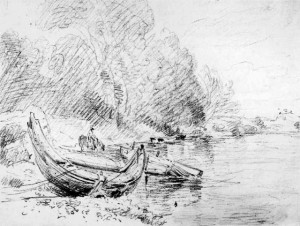
THE PURITANS of early America were famous for their austere clothing, as in this portrait of the famous poet Anne Bradstreet. While it is not true that the Puritans wore black all the time, they certainly scorned colorful and ornate dress. Laws in Massachusetts, New Jersey and Connecticut forbade clothing accessories such as silk scarves, cosmetics and pointy boots. Clothes were deliberately drab and they were also highly uniform.
The pursuit of exterior beauty was considered sinful in Puritan theology. Elegant clothes and buildings were too reminiscent of the magnificentia of Old Europe. All those cathedrals with their elaborate ornamentation, all those paintings and glorious archways, all those golden chalices and illuminated manuscripts — all were a lie. All this must be repudiated. It was impossible to please God with beautiful appearances. What mattered was whether you were one of the elect.
The modesty in dress the Puritans admired has been long cast off — militantly cast off. To defend the standards of modesty of that age is to defend tyranny and “supremacism.” Modesty indeed is positively wicked today.
But, as for the Puritans’ disdain of beauty? In that sense, we haven’t really come that far.
A young woman at the cash register at my local hardware store has bright pink hair — sometimes purple — and lurid-colored tattoos of a skull and a dagger plunging into a heart (or is it a hand?) on her arm. She also has black ear plugs. She seems so far from the gray-woolen skirts and white coifs of the Puritans that one can be sure she would never hold these as her model.
She has taken great pains — physical pains — to make herself as ugly as possible and I sense that she is proud of the look. But I get a lump in my throat when I see her. I realize we’re not supposed to notice these things. We’re supposed to travel through the world of dark and depressing imagery, of fashionable mutilation, unmoved. It would be ruthless elitism and snobbery to care.
But I wonder. Does she dress this way because she too believes beauty is a lie?
After all, she has surely been taught in school that her heritage, with its great artistic achievements and history of modest and quite beautiful clothing, was hypocrisy. She has been taught over and over again that beneath the beautiful appearances of the past were power and oppression of the weak.
In embracing ugliness is she saying: “Beauty is false?” In glorifying the horrific is she part of an ethical project, an effort to be more “authentic,” more true, more real? It’s interesting that so many people who dress in demonic-looking tattoos and black, Puritanical T-shirts are very nice people. They are not street toughs at all. In fact, they seem as if they could be knocked off their black-booted feet with a feather. Their niceness and their ugliness perhaps go hand-in-hand. Both are creating the perfect society, a world where all standards that might make anyone possibly feel left out are abolished.

The Puritans couldn’t imagine nor would they have remotely approved or intended the anti-fashions of today. But they were building a better world too. Though they punished certain violations in clothing, they believed ultimately externals don’t matter. In some ineffable way, they were seeking the sort of place the tatted and pierced want too.
If beauty is finally conquered then all can be equal in ugliness.
When God’s altars were stripped, it was only a matter of time before the Prince of Darkness, who has no body of his own to adorn and hates with a passionate jealousy the incarnate, would move in and start to make his hideous altars of flesh. Read More »













